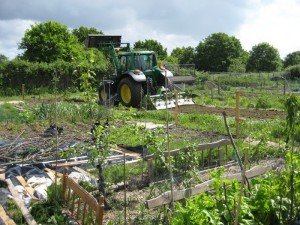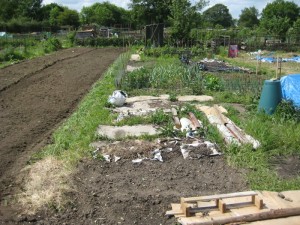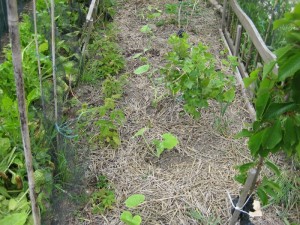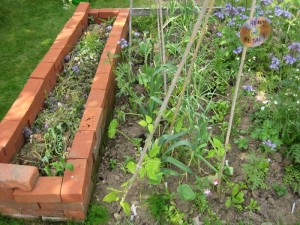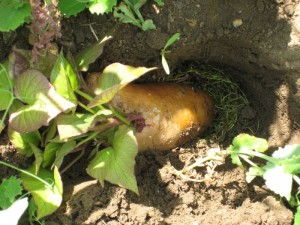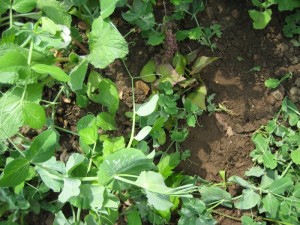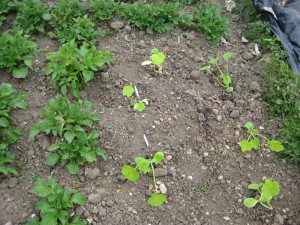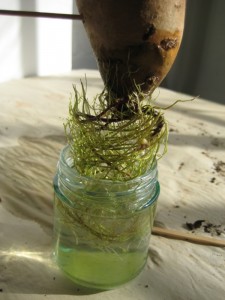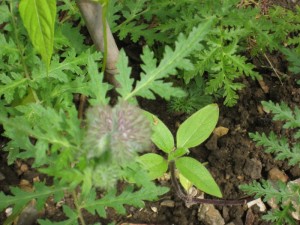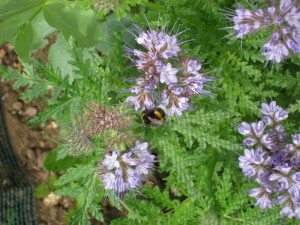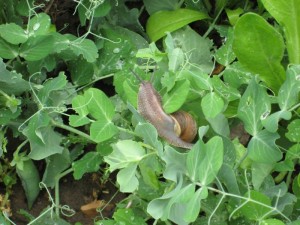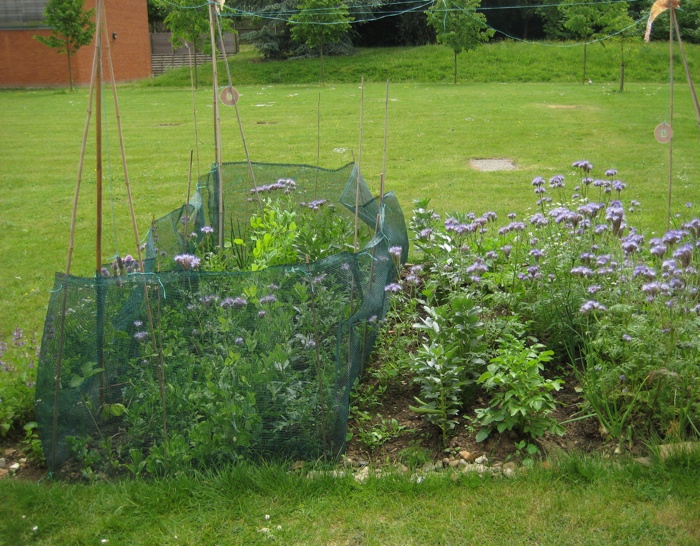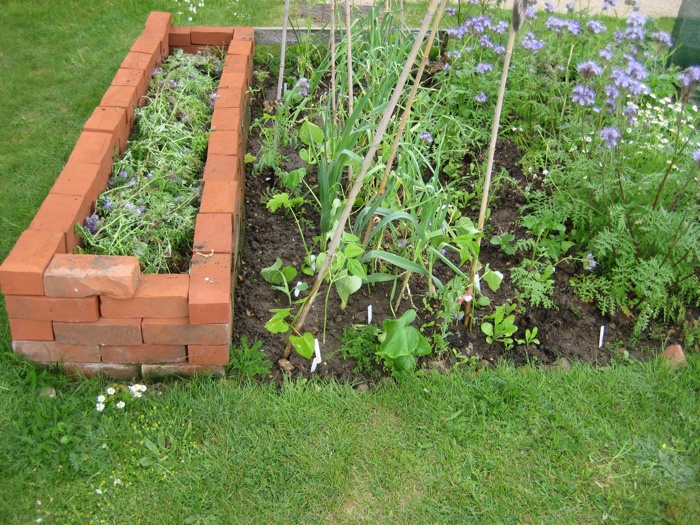18th April 2011 – In the studio the rooting Sweet Potato was observed sitting in its glass jam jar of water on the table in front of the window. The Sweet Potato was absorbing the sun light. A tiny dark reddish/ purple leafy sprout (slip) had emerged from the tuber. Ella Montt stared at the Sweet Potato, it was the first time she had witnessed so close the emergence of life from a Sweet Potato tuber. The root formations were of interest and also the initial growth of the leaf bud which will lead at a later stage to the vine structure.
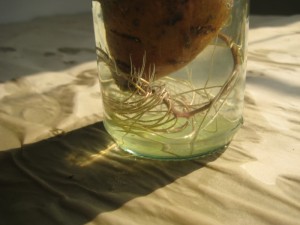

Later in the day, at Allotment Plot 326 an area was cleared of sticks and branches that had been cut from the original Apple Tree and lain on the ground for sometime, (the original Apple Tree existed on the Plot when possession was granted last August). This area of the Plot had been used by the previous tenant and was some how despite the drought still workable with the assistance of the fork and spade tools.
19th April – Water was applied with a watering can to Allotment Plot 326’s planted areas. Drought was still in occupation. Ella Montt planted five rows of Peas in the soil that she had been able to dig on the previous day. The Peas were the same types of seeds that were planted at Allotment Plot at MERL on 24th March; Pea Kelvedon Wonder, Pea Ambassador, Pea (Edible Podded) Ezetha’s Krombek Blauschokker, and Pea (Mange-tout) Oregon Sugar Pod. Ella Montt then pushed some of the Apple Tree sticks into the soil next to each row of Peas. The strategy of utilizing the sticks was to exploit a two-fold defense mechanism, potentially the first fold being an attempt to prevent Magpies and other wildlife from eating the Pea seeds and secondly to act as supports for the Pea plants as they grow. (Pea plants have tendrils that reach out to attach themselves to a supporting medium). A barrier net fence will also be needed to deter wandering wildlife from eating the plants.
26th April – Ella Montt erected a net fence around the area planted with Peas at Allotment Plot 326. Then water was applied to all planted areas of the Plot. Drought conditions persisted. Weeds were cut to decrease their power.

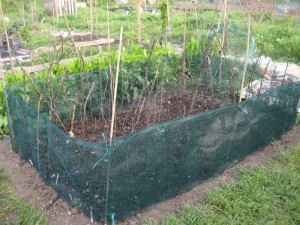
27th April – Cardboard that had been covering an area of Allotment Plot 326 was removed and placed close by on another area of the plot to assist in weed control. The uncovered area of soil was dug over. Seeds were then planted; these were Scorsonère Géante Noire De Russie, Leek Blue Green Winter and Kale Halbholter Grun Krauser. Once more water was applied to the planted areas of the Plot. The ground was forming cracks as moisture continued to evaporate and evade the soil. The lack of rain was becoming desperate. A sense of the Sahara spreading, edging nearer, drifted across the sky.
28th April – Allotment Plot at MERL had not been visited for two weeks, because of Spring time feasting. Ella Montt noted that certain vegetables plants had grown, but others had failed as yet to germinate. The green manure seeds Phacelia Tanacetifolia that had been planted last Autumn were now taking a positive hold in the Plot. Phacelia should be dug in with some plants left to attract bees, but Ella Montt decided to leave all the plants to flower (for now). The Garlic on the Plot had not as yet grown to be as big as the Garlic on Allotment Plot 326.
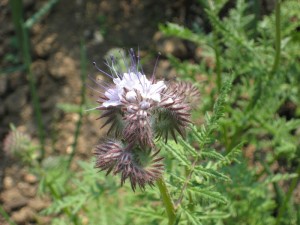
Ella Montt had brought Sunflower and Cosmos seedlings to the Plot. These seedlings that had been growing in the fixed up greenhouse at another location were becoming to tall and needed to be planted out. With intrepidation Ella Montt chipped away at the concreted soil to break holes for the seedlings to root themselves into the ground. The seedlings were then planted and watered as they connected to the earth. Two Globe Artichoke plants were also planted out. Seedlings planted; 5 Cosmos Cosmea, 19 assorted Sunflowers, 2 Artichokes = 1 x Arad and 1 x Imperial Star. Will they survive the drought?
It was still April and Ella Montt pondered the dangers of frost and other extreme weather conditions including the aforementioned drought. The Kale and Chard seeds had so far failed to germinate. Both the months of March and April had been exceptionally dry. The Sahara Dessert was spreading closer.
There was evidence of slug or snail damage on some of the plants, which seemed strange considering how dry the soil was. Perhaps the Brick Composter harboured these creatures. There appeared to be no bird damage affecting the plants. water was applied by watering can to the Plot. Both Carrot and Parsnip seeds were germinating.
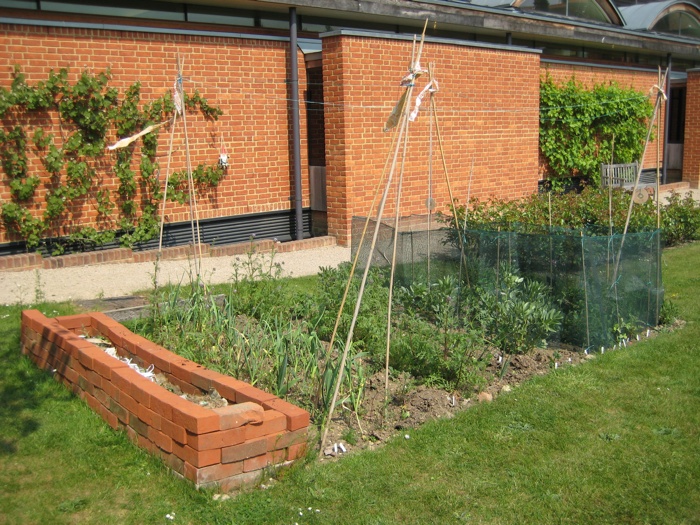
Ella Montt left Allotment Plot at MERL and cycled to the studio. The Sweet Potato was continuing to grow roots and shoots (slips).
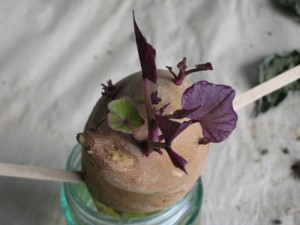
2nd May – Brassica seeds were planted in the fixed up greenhouse. The weather was playing havoc with Ella Montt’s timing of the cultivation process. Meanwhile the Squash and Bean plants were growing well, and waiting to be transplanted.
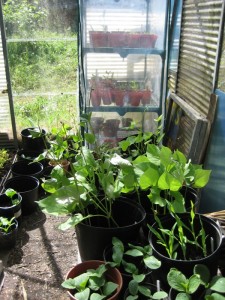
Ella Montt went to dig at Allotment Plot 326. Digging there was a never ending task and will be on going. The Potatoes foliage growth had accelerated. The ground was cracking with the lack of rain. Ella Montt dug an area that had been covered by cardboard and then planted some Cauliflower Snowball seeds, and also some Parsnip Halblange White, and Kohl Rabi Azur Star. It was hard to judge given the current weather conditions whether or not planting these seeds was a waste of time, but only the course of time will reveal this information. The sun continued to shine. The weather was for most humans, (apart from perhaps farmers, growers and firefighters) beautiful. The Garlic continued to thrust its foliage towards the sky.
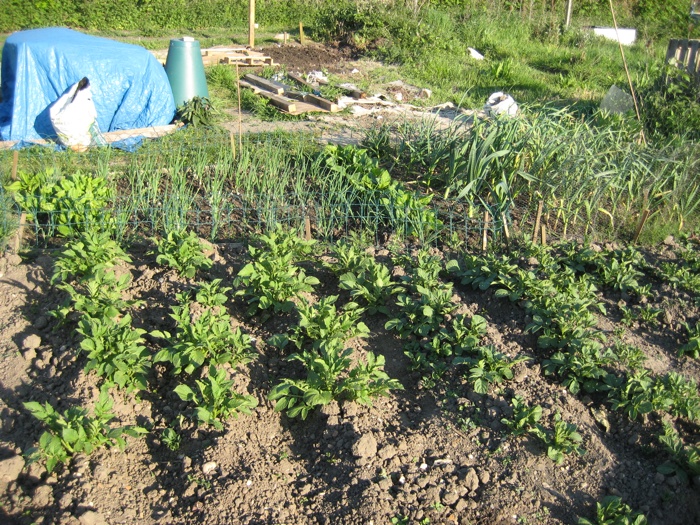
5th May – At Allotment Plot at MERL there was no evidence of frost damage, although the temperature had dropped the previous night and the night before. There had been a frost warning for rural areas. However the Sunflower seedlings that had been planted last week looked dead, because they had received no moisture since the day they were planted out. Ella Montt soaked the Plot with water in the hope to revive the Sunflowers. She then erected a fifth bamboo pyramid. Then five types of Bean plants from the fixed up greenhouse were transplanted into the ground. The Bean plants were; French Bean (Climbing) Barlotto Lingua di Fuoco, Blauhide, Blue Lake, and Neckarqueen, and Runner Bean Enorma.
Saved Squash seeds were placed into the soil within the Brick Composter as an experiment in the field of germination. The Comfrey plant that had planted on the 14th April was still in its place as part of the Plot, but it had been eaten by slime creatures. Comfrey as a plant has exceptional growth capacity and can be harvested several times at least a year, but creatures also find it a good food source. Allotment Plot 326 has revealed several Comfrey plants already established as part of that Plot.

6th May – The Sweet Potato continues to transform its self, whilst a Comfrey cutting, taken from The Herb Garden (Kate Corder, 2006), generates new growth.
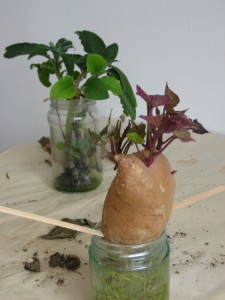
9th May – There was some relief for the plants as it rained at night on the 6th and 7th May ending the drought! A visit to Allotment Plot 326 revealed that frost had inflicted its cruel pain last week on the 3rd or 4th of May. Plot 326 is on higher ground than Allotment Plot at MERL and exists in a more rural area, which is where the weather person had indicated that frost might fall, and it had. Luckily only the foliage of the Potato plants were damaged and not the core plant. The Potato foliage should be able to regenerate, because the frost was not severe. The Peas somehow were unaffected and growing steadily.
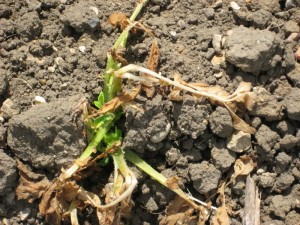
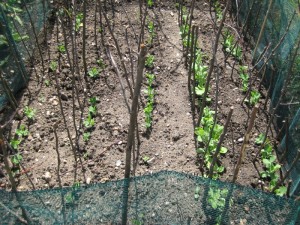
Ella Montt had become aware that a campaign against government interference with Allotment History was being fought across the land. It had been revealed of late that government is seeking to destroy and condem Section 23 of the Allotments Act of 1908, which binds local councils to provide land for allotments if more than six humans desire Allotments in a local area. Ella Montt, Captain Swing, Thorpe and William Morris were most displeased by the governments reckless behaviour.
A council worker operated a large green tractor in the plot next to 326, the vehicle was tuned to remove the rampant wildness that had taken over this particular plot, as a result of an allotment holder’s failed utopian dream. The previous allotment holder worked long hours and had to give up their plot so the plot will soon belong to the next person on the extensive waiting list. Ella Montt watched the tractor turn the soil and narrowly miss the Cherry Tree.
After more digging in an area that had been covered by newspaper and compost Ella Montt planted some seeds; Broccoli Purple Sprouting Early, Calabrese Green Sprouting, Brussels Sprouts Darkmar 21, and Cabbage Marner Lagerweiss. External forces will decide if these seeds will grow into vibrant green vital matter.
